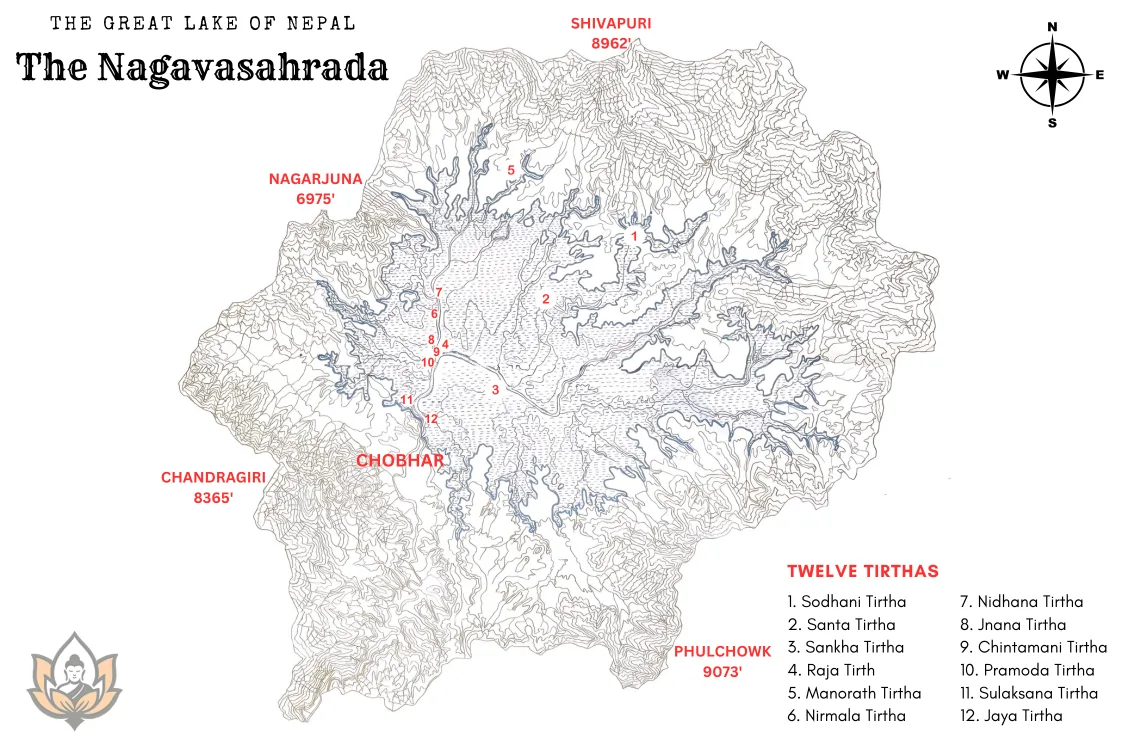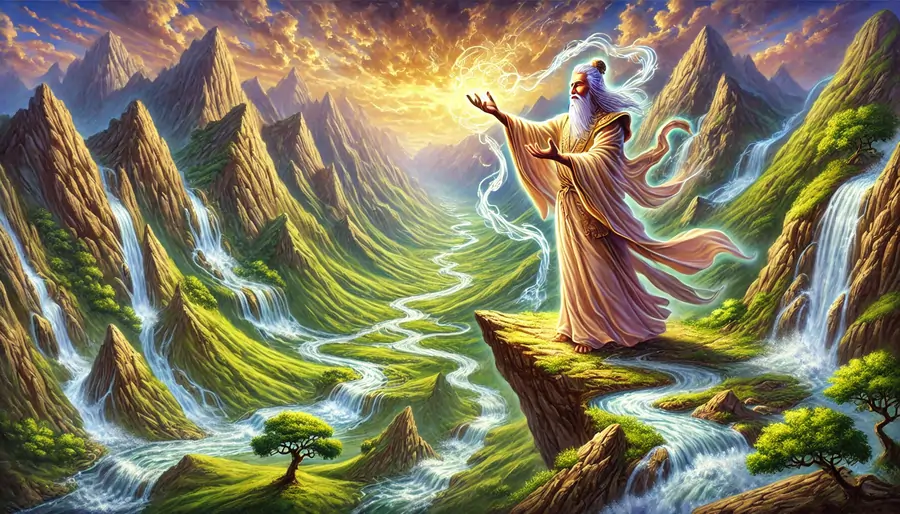The Arrival of Krakucchanda Tathagata
After the time of Vishwabhu Tathagata had passed, a long interval elapsed before the fourth Buddha in the lineage, Krakucchanda Tathagata, in Sanskrit क्रकुच्छन्द तथागत, the Fourth Buddha appeared on Earth to guide and protect sentient beings. This was time when human lives spanned 40,000 years. He lived in the land of Ksemavati during the Treta Yuga. Among his disciples was Jyotisapala, also known as the Follower of Astrology, who in another age would be reborn as Sakyamuni Buddha.
Krakucchanda Tathagata, while traveling to various holy places, was brought to the Nepal Valley to pay homage to the Khaganana, the Swayambhu Dharmadhatu, and the shrine of Manjushri. His visit to these sacred sites was undertaken with great reverence, and he stayed for some time on the Vajrakuta Parvata (present-day Swayambhu Hill).
After his stay on Vajrakuta Parvata, he was drawn to the mountain located to the north of the valley, known as Sankha Parvata (Conch Mountain), which is now called Shivapuri. There, he settled for a period and began delivering lectures on the Aryasatya (आर्यसत्य, Noble Truth).
The teachings of Krakucchanda Tathagata attracted many people, who gathered in large numbers to listen to his wisdom. Deeply inspired by his words, they expressed their desire to become Buddhist monks. Their requests for initiation into the Buddhist path were warmly received by Krakucchanda Tathagata.
Krakucchanda Buddha welcomed everyone present into the Buddha Dharma. All the people shaved their heads, wore red robes, carried alms bowls, and became monks (Bhikshus) and nuns (Bhikshunis). He then shared all types of Dharma teachings with the newly ordained monks and nuns, guiding them on the path to enlightenment (Bodhi). His teachings helped purify their minds, clear their thoughts, and remove all obstacles in their way. Their senses were cleansed, and their desires for personal gain or selfish needs disappeared. Through Krakucchanda Buddha’s guidance, they became free from all attachments, ready to walk the path of spiritual liberation.
The Creation of Sacred Streams
Sankha Parvata lacked a water source, but Krakucchanda Tathagata, through the miraculous power of his voice, created a stream that would later be known as the Vagmati (वागमती). The name, derived from the Sanskrit word Vak (वाक), meaning voice, signifies its divine origin. This river became revered for its holy properties, believed to cure leprosy and cleanse sins. Krakucchanda Buddha instructed the spirit of the Vagmati to flow freely, creating sacred tirthas (holy bathing sites) wherever other streams joined its waters. The river’s source, middle, and end were declared particularly sacred.
Krakucchanda Tathagata then created another great stream, the Kesavati (present-day as the Vishnumati River), at the site where the hair of newly ordained bhikshus and bhikshunis fell after their ordination. Kesavati derived from Sansrit word Kesa (केस), which is hair. The confluence of the Vagmati and Kesavati, along with other tributaries, gave rise to twelve holy tirthas that remain significant pilgrimage sites to this day.
Locations of 12 Tirtha and the Nagarajas
The twelve principal Tirthas (pilgrimages) hold supreme significance among all others and grant tremendous spiritual merits. Each Tirtha is associated with a specific Nagaraja (Serpent Deity) of Nagavasahrada, as detailed below:
- Sodhani Tirtha:
- Associated Nagaraja: Taksaka
- Location: Confluence of the Amoghaphaladai and Vagmati rivers in Gokarna, Kathmandu.
- Santa Tirtha:
- Associated Nagaraja: Somasikhi
- Location: Confluence of the Maradayani and Vagmati rivers in Guheswari, Kathmandu.
- Sankha Tirtha:
- Associated Nagaraja: Sankhapala
- Location: Confluence of the Manirobinirian, Rudradhara, and Vagmati rivers in Sankhamul, Kathmandu.
- Raja Tirtha:
- Associated Nagaraja: Surupa
- Location: Confluence of the Rajamanjari and Vagmati rivers in Teku, Kathmandu.
- Manorath Tirtha:
- Associated Nagaraja: Kulika
- Location: Confluence of the Kesavati (Vishnumati) and Vimalavati rivers in Tokha, Kathmandu.
- Nirmala Tirtha:
- Associated Nagaraja: Parala
- Location: Confluence of the Kesavati (Vishnumati) and Kusamavati rivers in Shova Bhagawati, Nepal.
- Nidhana Tirtha:
- Associated Nagaraja: Nandopananda
- Location: Confluence of the Kesavati (Vishnumati) and Suvarnavati rivers in Kanga, Kirtipur.
- Jnana Tirtha:
- Associated Nagaraja: Vasuki
- Location: Confluence of the Kesavati (Vishnumati) and Papanasini rivers in Kalimati, Kathmandu.
- Chintamani Tirtha:
- Associated Nagaraja: Varuna
- Location: Confluence of the Vagmati and Kesavati (Vishnumati) rivers in Teku Dobhan, Kathmandu.
- Pramoda Tirtha:
- Associated Nagaraja: Padma
- Location: Confluence of the Vagmati and Ratnavati rivers in Kuleshwor, Kathmandu.
- Sulaksana Tirtha:
- Associated Nagaraja: Mahapadma
- Location: Confluence of the Vagmati and Charumati rivers in Bhajangal, Kirtipur.
- Jaya Tirtha:
- Associated Nagaraja: Karkotaka
- Location: Confluence of the Vagmati and Prabhavati (Nakkhu) rivers in Nakkhu, Kirtipur.
These sacred sites, tied to the revered Nagarajas, continue to be essential destinations for spiritual seekers and devotees.

The Eight Vitaragas: Manifestations of Shiva
Then, Eight Vitaragas (अष्ट वीतराग) emerged as sacred manifestations of detachment, representing freedom from passion, attachment, and desire. These Vitaragas are closely associated with eight specific locations, each holding immense spiritual significance.
Note: Vitaraga means freedom from passion, attachment and desire.
These Vitaragas are believed to have appeared as pure energy and light, without a defined physical form, to bring welfare to the world. Their emergence is tied to eight sacred sites, which are visited by devotees seeking liberation from worldly attachments.
At these places, prayers and meditations are performed to reflect on the qualities of the Vitaragas. Those who sing, praises or chant the names of these eight manifestations can attain wisdom, prosperity, and ultimate spiritual liberation.
The Eight Vitaragas and their locations are as follows:
- Manichuda Vitaraga – मणिचूड वीतराग – Worshipped in Sankhu ( See in Map).
- Gokarna Vitaraga – गोकर्ण वीतराग – Revered in Gokarna ( See in Map).
- Kileshvara Vitaraga – कीलेश्वर वीतराग – Honored in Changu ( See in Map).
- Kumbheshvara Vitaraga – कुम्भेश्वर वीतराग – Worshipped in Patan ( See in Map).
- Garteshvara Vitaraga – गर्तेश्वर वीतराग – Venerated in Pharping (now known as Gopaleshor temple) ( See in Map).
- Phanikeshvara Vitaraga – फणिकेश्वर वीतराग – Also revered in Pharping (now known as Shesh Narayan temple) ( See in Map).
- Gandhesvara Vitaraga – गन्धेश्वर वीतराग – Honored in Chobhar (now known as Jal Vinayak temple) ( See in Map).
- Vikrameshvara Vitaraga – विक्रमेश्वर वीतराग – Worshipped in Sitapaila (now known as Aadeshwar temple) ( See in Map).
The eight Vitaragas are divine manifestations of Mahadev Shiva himself, revered for their ability to bring happiness to the world. Those who joyfully sing prayers and praises of these forms of Shiva are believed to attain the realm of ancestors, where they experience boundless happiness. By chanting the names of these eight Vitaragas with focus and devotion, individuals are said to gain prosperity, wisdom, and ultimately reach Shiva’s divine abode.
Note: In Newar Buddhism, Mahadev Shiva is revered as a directional guardian or Lokapala, serving as a protector of the Dharma and the Buddhist community. He is also worshipped during the Gurumandala Puja.
Swayambhu Purana – Table of Contents
« Chapter 4: Vishwabhu Tathagata: Manjushri and Birth of Nepal Valley
Chapter 6: Kanakamuni Tathagata: Dharmadhatu Vagishwara »

